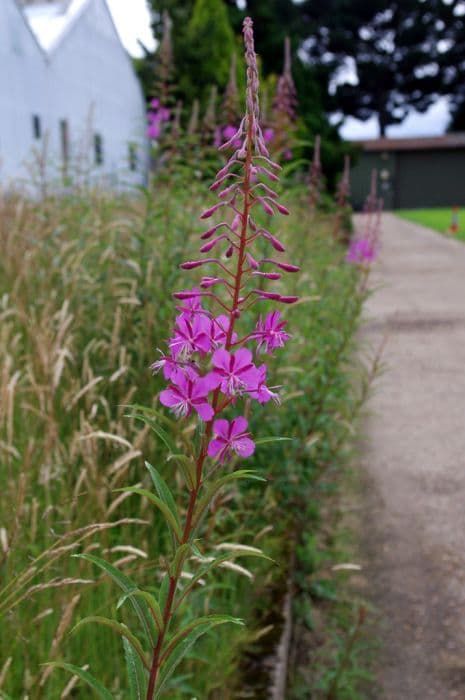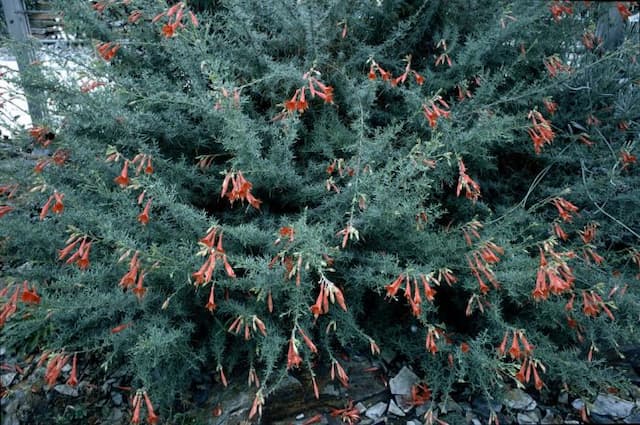Brilliant fuchsia Fuchsia fulgens (T)

ABOUT
The plant known as brilliant fuchsia is admired for its striking appearance, characterized by pendulous, tubular flowers that dangle like elegant ear drops. These flowers showcase a vivid combination of colors, usually featuring red sepals with a corolla that blends from pink to orange. Each of these blooms is quite intricate, possessing long, graceful stamens that extend from the flower's throat, adding to their decorative look. The foliage of the brilliant fuchsia is equally attractive, with large, soft, and velvety leaves that may exhibit a slight serration on their edges. They are arranged opposite each other along the stems, creating a lush backdrop for the showy flowers. The plant overall has a bushy, spreading habit, often with branches that arch gracefully under the weight of the blossoms. It is this combination of colorful flowers and elegant foliage that makes the brilliant fuchsia a popular choice for garden enthusiasts seeking to add a touch of tropical flair to their landscape.
About this plant
 Names
NamesSynonyms
Brilliant Fuchsia, Earring Flower
Common names
Ellops fulgens
 Toxicity
ToxicityTo humans
The plant commonly known as the Brilliant Fuchsia is not considered toxic to humans. Therefore, there are no specific symptoms of poisoning associated with this plant because it is generally considered safe. Ingesting any part of the Brilliant Fuchsia is unlikely to result in toxic consequences to humans under normal circumstances.
To pets
The Brilliant Fuchsia, similar to its safety profile in humans, is not known to be toxic to pets. Pets that ingest parts of this plant are unlikely to experience symptoms of poisoning. The ingestion of Brilliant Fuchsia should not pose toxic consequences to pets. However, it's always advisable to be cautious and prevent pets from eating plants, as individual animals might have sensitivities or allergic reactions.
 Characteristics
CharacteristicsLife cycle
Perennials
Foliage type
Deciduous
Color of leaves
Green
Flower color
Red
Height
1-2 feet (30-60 cm)
Spread
1-2 feet (30-60 cm)
Plant type
Shrub
Hardiness zones
9
Native area
Mexico
Benefits
 General Benefits
General Benefits- Aesthetic Appeal: Fuchsia fulgens, commonly known as the Brilliant Fuchsia, adds vibrant color and unique floral shapes to gardens and indoor spaces.
- Attracts Pollinators: Its tubular flowers are known to attract hummingbirds and other pollinators, thus promoting biodiversity.
- Suitable for Containers: It is well-suited for container gardening, allowing for vibrant displays on patios, balconies, and indoors.
- Versatility in Landscaping: Brilliant Fuchsia can be used in various garden designs, including hanging baskets, borders, and as an accent plant.
- Tolerates Shade: Unlike many flowering plants, Fuchsia fulgens can thrive in partial shade, making it valuable for shaded garden areas.
- Long Blooming Period: The plant has a lengthy flowering season, providing color and interest for an extended period.
- Easy to Propagate: It can be easily propagated from cuttings, making it simple for gardeners to expand their collection or share with others.
- Relatively Easy to Care For: With basic maintenance such as watering, feeding, and pruning, this plant can flourish and remain healthy.
 Medical Properties
Medical PropertiesThis plant is not used for medical purposes.
 Air-purifying Qualities
Air-purifying QualitiesThis plant is not specifically known for air purifying qualities.
 Other Uses
Other Uses- Fuchsia plants are often used as a food dye due to their vibrant colors, contributing to natural and appealing hues in various food items.
- In some cultures, fuchsia flowers are used to make a flavorful tea, offering a unique taste experience.
- The berries of some fuchsia species, including Fuchsia fulgens, are edible and can be used to create jams, jellies, and pies.
- These plants are commonly used in ornamental horticulture, providing striking color contrasts for borders and flower arrangements.
- Fuchsia can be incorporated into living fences or hedges, offering both aesthetic appeal and privacy for garden spaces.
- Due to their attractiveness to hummingbirds, fuchsia plants serve as an ecological addition to gardens to attract and support these pollinators.
- Fuchsia flowers are occasionally used in crafting, such as for pressing in books or making decorative items like bookmarks and cards.
- Fuchsia plants can be trained into various forms, such as standards or topiaries for garden design and sculptural elements in landscapes.
- The plant's fast-growing habit makes it useful for covering unsightly areas in gardens, such as walls or fences, quite rapidly.
- Some gardeners use the fallen fuchsia flowers as a colorful, natural mulch to retain moisture and suppress weeds while adding aesthetic value.
Interesting Facts
 Feng Shui
Feng ShuiThe Fuchsia is not used in Feng Shui practice.
 Zodiac Sign Compitability
Zodiac Sign CompitabilityThe Fuchsia is not used in astrology practice.
 Plant Symbolism
Plant Symbolism- Confiding love: The fuchsia flower, often found in hanging baskets, represents confiding love. It's seen as an offering of trust and an invitation to share innermost thoughts.
- Good taste: With its elegant drooping flowers and striking color combination, the fuchsia is also viewed as a symbol of good taste and sophistication in the language of flowers.
- Ardent affection: The vibrant and vivacious colors of the fuchsia are commonly associated with a deep and passionate affection. Giving someone a fuchsia expresses a heartfelt emotion.
- A warning of betrayal: In some traditions, the fuchsia is seen as a plant that warns of approaching betrayal, with its delicate teardrop shape hinting at the tears to come.
 Water
WaterThe Brilliant Fuchsia should be watered thoroughly, allowing the top inch of soil to dry out before watering again. This usually means watering approximately once a week, but this can vary depending on environmental factors like temperature and humidity. During the growing season, the plant may need more frequent watering, maybe every few days. Use lukewarm water and aim to water the plant with about one to two gallons, depending on the size of the pot and the plant's needs, ensuring even moisture distribution without soggy soil. Be cautious during winter months; water less frequently, as the plant requires less moisture during dormancy.
 Light
LightThe Brilliant Fuchsia thrives in bright, indirect light. It is best to place the plant in a location where it can receive morning sunlight and afternoon shade, as too much direct sunlight can lead to leaf scorch. A north- or east-facing window is ideal, providing the soft light this plant prefers to maintain vibrant foliage and blooms.
 Temperature
TemperatureThe Brilliant Fuchsia does best in cool to moderate temperatures, ideally between 55°F and 75°F. It's important to avoid temperatures below 40°F, as the plant can suffer from cold damage. Conversely, temperatures above 80°F can stress the plant, leading to poor growth and potential heat damage.
 Pruning
PruningThe Brilliant Fuchsia benefits from pruning to encourage branching, which results in a fuller plant with more flowers. Prune in early spring, before active growth begins, cutting back by about a third. Remove any dead or damaged wood and thin out crowded branches. Pruning can be done again after flowering to maintain shape and size.
 Cleaning
CleaningAs needed
 Soil
SoilThe best soil mix for the Fuchsia, commonly known as 'Brilliant Fuchsia,' is a well-draining mix with a peat-based potting soil, perlite, and loam. It should be slightly acidic to neutral, aiming for a pH between 6.0 and 7.0. Regular organic matter additions like compost or leaf mold will help maintain fertility and structure.
 Repotting
RepottingBrilliant Fuchsia should be repotted every 2 to 3 years or when it has outgrown its current pot. It's essential to refresh the soil and upsize the pot if roots are visible at the surface or growing through drainage holes. Early spring is the ideal time for repotting, just before the new growth starts.
 Humidity & Misting
Humidity & MistingBrilliant Fuchsia prefers high humidity levels, typically around 60-70%. This can be achieved in a home environment by using a humidifier, placing the plant on a pebble tray with water, or situating it in a naturally humid room like a kitchen or bathroom.
 Suitable locations
Suitable locationsIndoor
Place in bright, indirect light and maintain high humidity.
Outdoor
Place in dappled shade, shelter from strong winds.
Hardiness zone
9-11 USDA
 Life cycle
Life cycleFuchsia fulgens, commonly known as the Brilliant Fuchsia, begins its life cycle with seed germination, occurring in moist, well-drained soil and a warm environment. Upon germination, the seedling emerges and develops into a young plant with characteristic lance-shaped leaves and begins to form a bushy structure through branching. As the plant matures, it enters the vegetative stage, displaying vigorous growth of foliage and stems. The Brilliant Fuchsia then transitions to the flowering stage, producing distinctive tubular red-orange flowers with long stamens that are attractive to hummingbirds and other pollinators. After pollination, the flowers develop into small, dark-colored fruits containing seeds, which can disperse to propagate new plants. In many climates, the Fuchsia fulgens will experience a period of dormancy during colder months and will resume growth in spring, completing its perennial cycle.
 Propogation
PropogationPropogation time
Spring-Early Summer
Fuchsia fulgens, commonly known as the Brilliant Fuchsia, is typically propagated through softwood cuttings, a popular method that allows for rapid multiplication of plants while maintaining the characteristics of the parent. This process is best done in the spring or early summer when the plant is actively growing. To propagate, a healthy, non-flowering stem is selected and cut just above a set of leaves, usually making the cutting about 4 to 6 inches long (10 to 15 centimeters). The lower leaves are removed, and the cut end may be dipped in rooting hormone to encourage root growth. The cutting is then placed in a well-draining soil mix, and the environment is kept humid by covering the pot with a plastic bag or placing it in a propagator. With regular misting and a warm temperature, roots typically develop within a few weeks.









